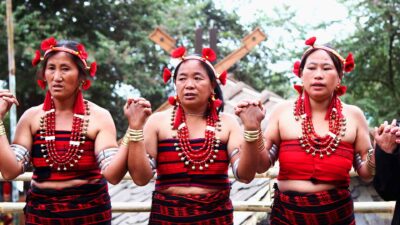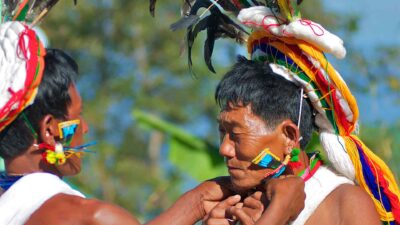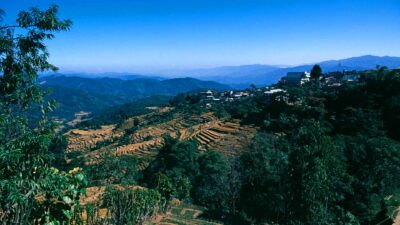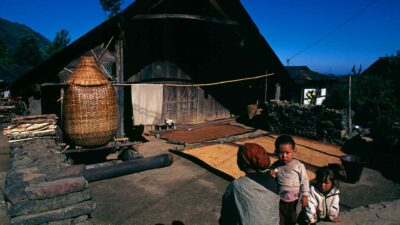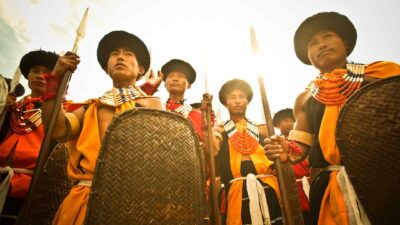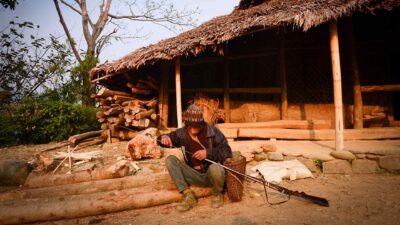Discovering the tribes of Nagaland
12 days
Visiting Nagaland at least once in your lifetime means discovering a unique and authentic corner of India, where history, culture, and nature intertwine in an emotional story. Nestled among the Naga and Patkai hills, on the border with Myanmar, this land has always been home to over 16 indigenous tribes, each with its own rituals, festivals, and traditional arts. Its people have managed to transform their past as proud and independent warriors into an extraordinary testimony of resilience and conservation. Khonoma, for example, was the stronghold of resistance against the British in the 19th century and is now India’s first “green village,” a symbol of respect for nature and its own roots.
The mist-covered hills, terraced fields, and trails crossing forests and villages: the landscape itself tells the story of a timeless region, where every bamboo house and every totem speaks of a strong and authentic identity.
With this itinerary you can experience the best that Nagaland has to offer: you will explore historic villages like Khonoma, among megaliths and hanging gardens, and stroll through the alleys of Kohima, with its memories of World War II and lively markets. If you travel in December, you will attend the Hornbill Festival, one of the most spectacular tribal celebrations in the world, with dances, songs, and traditional games involving all the tribes of Nagaland.
You will then head to Mokokchung, the spiritual heart of the Ao, where legends and postcard-like landscapes merge, and reach Mon and Longwa, to meet the Konyak, recognizable by their tattooed faces and the imposing tribal houses adorned with hunting trophies.
During the journey you can also walk along trails in the protected forests of the Khonoma Nature Sanctuary, look for the rare Blyth’s tragopan, walk through terraced rice fields, and discover the secrets of artisans and blacksmiths who still work metal and wood today as they did centuries ago.
An experience that is not just a trip, but a true encounter with the history, nature, and most authentic soul of India. An opportunity to experience ancient cultures up close, breathe the peace of the hills, and return home with a wealth of unforgettable emotions.
JOURNEY OVERVIEW AND PROGRAM DETAILS
DAY 1: ARRIVAL IN KOLKATA
Kolkata
Arrival at Kolkata International Airport and check in at the Hotel. Kolkata, is the capital of the state of West Bengal. Located on the east bank of the Hooghly River, it is the main commercial, cultural and educational center of East India, and its port is the oldest in the country and the only river port. Calcutta was the capital during British colonialism, for this reason preserves in many buildings the architectural style of that period, which contrasts sharply with the degradation of some urban areas and with the more recent and dynamic suburbs and with the inevitable air-conditioned shopping centers. After a short rest, visit the Indian Museum, Victoria Memorial hall, St. John’s Church, and Kali Temple.
Overnight in Kolkata
DAY 2: VISIT OF KOLKATA
Kolkata
In the morning after breakfast, you will have the opportunity discover the cultural heritage of the North of Kolkata, which includes the ancient noble palaces and mansions, the potter’s village in Kumartuli, the lively local shops and the narrow streets and alleys from which the city has evolved in a few centuries. After lunch, visit Missionaries of Charity and take part in feeding and pampering the specially abled Orphan Children, playing and dancing with them. Afterwards visit Mother’s House, the place where Mother Teresa spent most of her life. In the Evening, you will be taken to Iskcon Temple to have Darshan of Evening Arati. Enjoy the Ecstatic Kirtan and dancing in front of the Deities. Evening Dinner Prasadam at Govinda’s Restaurant.
Overnight in Kolkata. (B, D)
DAY 3: TRANSFER TO KHONOMA VILLAGE
Dimapur – Khonoma
After arrival at Dimapur Airport, drive towards the hills of Nagaland (approximately 2–3 hours) until reaching Khonoma, a village of great historical and cultural significance for the Angami tribe. Known as the “first green village of India” for its strong conservation ethos, Khonoma was also the site of two important battles against the British, in 1847 and 1879, making it a symbol of tribal resistance.
The village lies nestled among terraced fields and evergreen forests, with a striking mix of megalithic monuments, stone pathways, and traditional Angami homes built of wood and bamboo. During a first orientation walk through the lanes of the village, you will notice flowering gardens, pomelo trees, and hanging vines of squash and gourd—symbols of local self-sufficiency and ecological harmony.
The afternoon is free to relax or explore the surroundings independently. For those interested, a short optional walk can be arranged to the community forest area, where local youth initiatives have preserved biodiversity and birdlife for generations.
Overnight in Khonoma. (B, L, D)
DAY 4: DISCOVERING KHONOMA AND TRANSFER TO KOHIMA
Khonoma – Kohima
After breakfast, the day opens to a slow immersion into the cultural and ecological soul of Khonoma. Once a fierce stronghold of Angami warriors, Khonoma is now a pioneer in community-led conservation. With its “Green Khonoma” initiative, it became the first village in India to officially ban hunting and logging, transforming its forested hills into a living sanctuary of biodiversity and tribal resilience.
In the morning, take a guided walk to the Khonoma Nature Conservation and Tragopan Sanctuary, a community-protected forest rich in birdlife and endemic flora. With a bit of luck, you may catch sight of the Blyth’s Tragopan, a rare and beautifully plumed pheasant native to this region and emblematic of the village’s conservation efforts.
Later, stroll through the stone-paved alleys of the village, past ancestral homes, rice granaries, and megaliths, as elders share stories of resistance, rituals, and revival. The landscape is alive with organic farming, terraced fields, and flowering creepers—a quiet testament to sustainable living.
In the late afternoon, transfer to Kohima (approx. 1 hour), the capital of Nagaland, located at 1,444 meters above sea level. Once the site of a pivotal World War II battle, today Kohima offers a vibrant blend of traditional Naga identity and contemporary urban life.
Overnight in Kohima. (B, L, D)
DAY 5: EXPLORING KOHIMA – HERITAGE, HISTORY AND TRADITION
Kohima
After breakfast, the day unfolds with a cultural immersion into the capital of Nagaland. If your visit falls in early December, you will have the unique chance to witness the Hornbill Festival, one of India’s most vibrant tribal celebrations. Held annually at Kisama Heritage Village just outside the city, the festival brings together all sixteen recognized Naga tribes in a kaleidoscope of traditional dances, music, warrior games, crafts, and indigenous cuisine. It is a rare window into the richness and diversity of Naga heritage.
Outside the festival season, Kohima still offers many historical and cultural treasures. Begin with a visit to the World War II Cemetery, a serene and poignant memorial honoring the soldiers who died in the Battle of Kohima—one of the fiercest fought on Indian soil. Continue to the Reconciliation Cathedral, perched on Aradura Hill, one of the largest churches in India and an architectural landmark known for its sweeping murals, woodwork, and panoramic views over the valley.
In the afternoon, explore the Nagaland State Museum, which houses a remarkable collection of tribal artifacts including traditional attire, weapons, jewelry, musical instruments, and ceremonial objects—each narrating stories of origin, belief, and craftsmanship.
The evening is free to relax or explore the town’s lively markets and cafés at your own pace.
Overnight in Kohima. (B, L, D)
DAY 6: FROM KOHIMA TO MOKOKCHUNG – THROUGH HILLS AND HERITAGE
Kohima – Mokokchung
After an early breakfast, the journey resumes with a long but scenic drive (approx. 7–8 hours) across the rolling hills of Nagaland, moving from the Angami world of Kohima to the cultural heartland of the Ao Naga tribe—Mokokchung. This vibrant hill town is renowned for its strong literary traditions, woodcraft, and dynamic festivals, making it a vital centre for the preservation of Ao heritage.
En route, pause for a short visit to Touphema Village, a community-run heritage village developed to showcase traditional Naga lifestyle. Thatched huts, central hearths, and symbolic carvings offer a glimpse into everyday life before modernity—an ideal introduction to the cultural threads that knit Nagaland’s tribal mosaic.
As you continue the journey, the road winds through pine-clad slopes, bamboo groves, and terraced farms, revealing panoramic vistas and glimpses of rural life.
Arrival in Mokokchung by evening. The rest of the day is at leisure to rest or explore the quiet rhythms of the town.
Overnight in Mokokchung. (B, L, D)
DAY 7: THE SOUL OF THE AO NAGAS
Mokokchung
After breakfast, the day opens to the cultural roots of the Ao Naga people. Begin with Mopungchuket, a village steeped in legend—home to the tragic love story of Jina and Etiben. Walk past the Time Pillar, where carvings recount tribal migrations and ancestral battles, and pause at the sacred lake once used for rituals before war.
Continue to Aliba, the site where the Aos first embraced Christianity in 1872. After lunch, visit Longkhum, known for its panoramic views over the Doyang valley, and Ungma, the largest Ao village, where elders still bear traditional tattoos and oral histories linger in the air.
Return to Mokokchung for the night, carrying the echo of songs, stories, and stone.
Overnight in Mokokchung. (B, L, D)
DAY 8: INTO KONYAK TERRITORY
Mokokchung – Mon
After breakfast, depart for Mon, a long but scenic journey (6–7 hours) through the forested Patkai hills toward the northeastern edge of Nagaland. This remote region is home to the Konyak, the most emblematic of Naga tribes, once feared as headhunters and now admired for their artistry and fierce identity.
With their tattooed faces, necklaces of brass skulls, and handcrafted rifles, the elder Konyaks still bear the legacy of a warrior past. Their distinctive longhouses, decorated with animal skulls and wood carvings, reflect a culture steeped in ritual, courage, and ancestral pride.
Arrive in Mon by evening and settle in. The atmosphere is quiet but charged with the gravity of a land where myth and memory are never far apart.
Overnight in Mon. (B, L, D)
DAY 9: AMONG THE KONYAKS
Mon
After breakfast, set out to explore the Konyak villages surrounding Mon, where time seems to have paused. If you’re traveling in early April, you may witness the Aoleang Festival, a spring celebration marked by traditional dances, rituals, and tribal pride.
Visit Hongphoi, Wangla, and Old Mon, where the warrior legacy of the Konyaks is still visible in the tattooed faces of village elders and the longhouses adorned with buffalo skulls and carved wooden symbols of past hunts. Chiefs’ houses stand proudly with their palm-leaf roofs and massive timber beams, echoing centuries of tradition.
Craftsmanship, oral history, and a strong communal rhythm define life here. Walking these villages offers a rare glimpse into one of the most unique tribal cultures of South Asia.
Overnight in Mon. (B, L, D)
DAY 10: LONGWA – AT THE EDGE OF TWO WORLDS
Mon – Longwa – Mon
After breakfast, head east toward Longwa, one of the most iconic Konyak villages, dramatically straddling the India–Myanmar border (2-hour drive). The house of the Angh (village chief) stands symbolically across two nations—half in India, half in Myanmar—offering a glimpse into a world where borders are drawn on paper but not in spirit.
Meet the Angh and his family, guardians of an oral tradition that blends ancestral wisdom and fierce independence. Explore the Morungs, traditional dormitories where boys were once initiated into tribal life, and see the war trophies, log drums, and blackened relics of headhunting days.
Walk through the village, admire local metal crafts and tribal jewelry handmade by artisans, and observe the rhythm of daily life: women weaving, children playing by the fires, and men working on Jhum (slash-and-burn) fields that terrace the green hills.
In the afternoon, return to Mon, carrying stories that stretch beyond borders.
Overnight in Mon. (B, L, D)
DAY 11: RETURN TO THE PLAINS
Mon – Dibrugarh
After breakfast, leave behind the forested hills of Nagaland and begin your descent toward the plains of Assam, driving for approximately 5–6 hours. As the landscape changes from rugged slopes to tea-covered lowlands, the air grows heavier and the pace slows.
Upon arrival in Dibrugarh, a quiet yet historic town on the banks of the Brahmaputra River, check in and relax. In the late afternoon, head to the riverside promenade for a sunset walk, where the vastness of the river mirrors the sky and fishermen return with their nets.
Evening at leisure. You may wish to explore the local markets, rich in spices, silks, and the earthy pulse of Assamese daily life.
Overnight in Dibrugarh. (B, L)
DAY 12 DEPARTURE
Dibrugarh
After breakfast, leave for Dibrugarh Airport for your departure flight.
ACTIVITIES
- Explore the colonial and artistic heritage of Kolkata, from North Calcutta mansions to Kumartuli’s potters’ quarter.
- Visit Mother Teresa’s Missionaries of Charity and her House, meeting the orphaned children and learning about her legacy.
- Discover Khonoma, India’s first “green village,” and walk in its community-run conservation forest.
- Learn about Angami tribal resistance and sustainable farming practices in the terraced hills of Nagaland.
- Walk through Kohima’s WWII battlefield cemetery and visit the Nagaland State Museum to understand Naga identity.
- Experience the Hornbill Festival (in December), a celebration of all 16 Naga tribes through dance, music, and ritual.
- Travel through the remote highlands to Mokokchung, home of the Ao Naga people, and explore legendary villages like Mopungchuket and Ungma.
- Visit the place where the first Aos converted to Christianity in 1872 and see sacred lakes, log drums, and carved stone time markers.
- Enter Konyak territory in Mon and Longwa, meeting tattooed elders and discovering ancestral longhouses.
- Interact with the Angh (tribal chief) of Longwa, whose house sits across the India–Myanmar border.
- Observe traditional metalwork, wood carving, and tribal tattoo culture still alive in remote villages.
- Walk through farmlands where Jhum cultivation is still practiced and experience daily rural life.
- Enjoy a sunset over the Brahmaputra River in Dibrugarh and explore lively Assamese markets.
SOCIAL AND ENVIRONMENTAL IMPACT
This itinerary has been designed with a strong focus on social responsibility and environmental awareness. The regions involved—Nagaland and Upper Assam—are among the least visited in India, and for this reason, tourism here plays a crucial role in supporting local economies, preserving cultural identities, and promoting ecological balance.
Whenever possible, accommodation and services are sourced from community-based operators, including family-run guesthouses, tribal homestays, and heritage villages managed by local cooperatives. These structures not only offer authentic experiences, but also ensure that tourism revenues are fairly distributed and contribute directly to the development of the areas visited.
A central element of the journey is the encounter with tribal communities—such as the Angami, Ao, and Konyak peoples—who preserve unique knowledge systems, crafts, and oral traditions. Visits to their villages are always arranged with prior consent and follow ethical guidelines, respecting local customs and ensuring a non-intrusive approach. Guests are encouraged to purchase handicrafts and textiles directly from artisans, supporting micro-economies and traditional skills.
From an environmental point of view, the itinerary highlights best practices in conservation. In Khonoma, for example—recognized as India’s first “green village”—travelers witness an exemplary model of community-led environmental protection. Plastic use is minimized throughout the trip, and guests are invited to bring reusable items (such as bottles and bags) to reduce their ecological footprint.
By reaching out to peripheral regions, this itinerary helps spread the benefits of tourism beyond the usual circuits, contributing to more equitable development and fostering pride in local cultures. At the same time, it offers travelers an opportunity to explore remote landscapes and traditions in a responsible and meaningful way.
TIPS BEFORE DEPARTURE
This itinerary includes areas that are still far from the circuits of mass tourism. Villages are often isolated, roads long and winding, and accommodations simple but selected with care. Electricity may be intermittent, phone coverage unreliable, and infrastructure minimal. None of this is a problem—if understood in advance.
Traveling through Nagaland means adjusting your pace and expectations. Encounters here follow their own timing, and relationships with space, silence, and hospitality often defy our usual frameworks. It’s important to approach these experiences with openness and without filters—letting go of comparisons, schedules, and assumptions.
Cultural dynamics vary widely from one village to another. In some communities, photography is welcomed; in others, it is not. The same goes for questions, gestures, and social interactions. There’s no written code—just a need for attention, sensitivity, and respect.
Weather conditions can change quickly, especially in the hills. A degree of unpredictability is part of the journey. Being prepared—mentally more than logistically—makes all the difference. This is not a trip for those seeking comfort or fast-paced sightseeing. It’s for those who want to understand a different way of living, through presence rather than observation.
HOTELS
Accommodation throughout Nagaland is simple but welcoming, with an emphasis on local character and proximity to cultural experiences. In Khonoma, Mokokchung and Mon, small family-run properties reflect the spirit of community hospitality. In Kolkata and Dibrugarh hotels are higher category with a stain of colonial-era offering more comfort and space. Standards vary by location, but all stays are chosen for their authenticity and connection to place.
TRANSPORT
All transfers are provided in private vehicles, adapted to the mountain and rural roads of Nagaland. Where possible, comfortable SUVs or vans with air-conditioning are used, especially for long-distance drives. Some internal routes may involve uneven or narrow roads, but all drivers are local professionals familiar with the terrain. 2 internal flights Kolkata- Dimapur and Dibrugharh- Kolkata are included in the price.
WHEN TO GO
The best season to travel is between October and early April, when the climate is dry and cool, and the road conditions are more favourable. December is a particularly interesting period thanks to the Hornbill Festival, which gathers the sixteen tribes of Nagaland in a major cultural celebration in Kohima.
March and early April offer another special opportunity to attend the Aoleang Festival in Mon, a spring ritual of the Konyak people. From late April onward, temperatures rise significantly and the heat can become uncomfortable, especially in the plains of Assam.
The monsoon season, from mid-May to September, brings heavy rainfall that can affect mobility and make access to remote areas more difficult. During this time, many tribal markets and events become less frequent or are suspended altogether.


